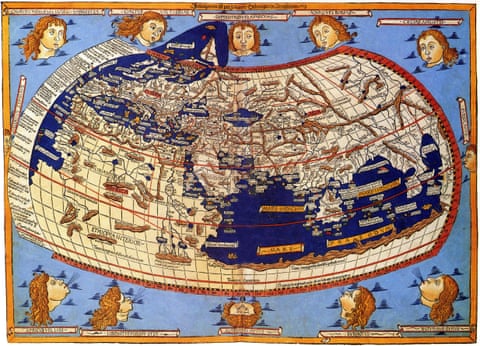Maps are not just informative, they are empowering. They can help provide a new perspective to age-old problems. But maps are not necessarily fixed – they often need renewing. As Albert Einstein said, “You can’t use old maps to explore a new world.”
While there are reasons to be uneasy about the future, maps can also inspire optimism. They not only reveal incredible progress, but also signal how a combination of political leadership, smart incentives and regulatory pressure can improve our human condition.
Map-making is an ancient impulse. For tens of thousands of years, Homo sapiens has etched the nearest water source, herd of deer or unfriendly neighbours on cave walls, boulders and parchment. The oldest known world map, Imago Mundi, was drafted more than 2,500 years ago in Babylon (in present day Iraq). An even more influential global map was Geographia, produced by the Greek astronomer, geographer and mathematician Ptolemy in 150AD. While incomplete and inaccurate, such maps helped people start making sense of their surroundings.
For much of human existence, most of the world was considered to be unknown and dangerous. This started to change after the Flemish cosmographer and cartographer Gerardus Mercator developed a new mapping technique in the mid-1500s. Geographers such as James Gall in 1855 and Arno Peters in 1970 introduced modifications that fixed distortions (known as the Galls-Peters projection), but Mercator’s maps still adorn classrooms virtually everywhere.
Quick GuideWhat is the Upside?
Show
Ever wondered why you feel so gloomy about the world - even at a time when humanity has never been this healthy and prosperous? Could it be because news is almost always grim, focusing on confrontation, disaster, antagonism and blame?
This series is an antidote, an attempt to show that there is plenty of hope, as our journalists scour the planet looking for pioneers, trailblazers, best practice, unsung heroes, ideas that work, ideas that might and innovations whose time might have come.
Readers can recommend other projects, people and progress that we should report on by contacting us at theupside@theguardian.com
Now another cartographical revolution is under way, with the advent of satellite imagery and our ability to superimpose data on to this two-dimensional view of the world. Now more than ever, maps can offer deeper insights, sudden revelations, clear signs of progress, or even potential answers to some of the gravest threats we face.
Power play
The climate crisis is the biggest challenge to our collective survival. Progress can be hard to glean – until you consider the quiet but inexorable rise of renewable energy. This map shows its rapid proliferation across the US over the past 35 years. It is possible that all 50 US states could move to 100% renewable grid energy by 2050.
US energy transition – 1984-2020
Bridging digital divides
Maps show how digital divides are shrinking. But they also reveal how some parts of the world are still digitally disconnected. In wealthy countries, more than 85% of the population has access to the internet, whereas the average for developing countries is 43%.
Still, the growth in connectivity over the past generation has been remarkable and transformative. An estimated 75bn devices will be linked to every person, place and company by 2025. Getting connected is now an essential driver of economic growth.
Share of population using the internet – 1990-2020
More educated than ever
While Covid-19 is profoundly disrupting elementary, secondary and tertiary schooling around the world, humanity has come an extraordinarily long way in a very short period of time. As the map shows, most people living outside North America and western Europe had fewer than four years of education in 1950.
Mean years of schooling – 1950-2020
Roughly 70 years later, the average duration of schooling has doubled. The number of children and adolescents out of school has also plummeted in recent decades. In the 1970, roughly 27% of primary-aged schoolchildren were out of school: today, it is closer to 8%. Just as impressive is the fact that most parts of the world are closing in on gender parity at the primary school level. These extraordinary gains have powered development and even helped democracies to flourish.
Of course, not everyone is benefiting equally from the education revolution. At least 120m million children are still out of school. Another 250 million young people have yet to acquire basic skills in literacy and numeracy. There are still at least 750 million young people and adults who can not read or write.
Children living longer
Children aren’t just better educated – they are more likely to survive childhood than ever before.
For most of our existence, newborns had even odds that they would live to five years of age. Human remains gathered from hunter-gatherer societies show mortality rates as high as 70%. As recently as the middle of the 19th century, one in two children died before they turned five. Today, a child dying before it reaches school age is a comparatively rare event – around 1 in 27 globally, compared with 1 in 11 in 1990.
Child mortality under-5 – 1950-2020
While this is still unacceptably high, it is a remarkable improvement on the past.
Life extensions
Notwithstanding the many threats and challenges on the horizon, more people are living longer and healthier lives than at any time in history. Depending on where her parents live, a child born in 2000 can expect to live for at least 100 years. A wave of new research into gene editing and regenerative medicine is raising the possibility that human life could be extended by an order of magnitude longer. Of course, the principal reason people are living longer is because human health has improved. Better health is a result of remarkable advances in everything from medicine and lifestyles to quality of nutrition and care.
One of the clearest indicators of improving human health is global life expectancy at birth. For most of the past 200,000 years, life was short, often brutally so. Most people did not live more than 25 years, and child mortality was off the chart. Then something extraordinary happened. Global life expectancy shot up in the 19th century and then doubled in the 20th century, the blink of the eye in evolutionary terms. Not everywhere has improved at the same pace: in Japan, people live on average to 85, while in the Central African Republic life expectancy is closer to 53. While these disparities are unacceptable, the prolongation of life is one of humanity’s greatest achievements.
Life expectancy by country – 1960 and 2020
When confronted with these formidable problems, there is a danger that we succumb to pessimism and paralysis. That would be precisely the wrong thing to do. Maps can help remind us that solutions are to be found not by retreating from difficult challenges, but in closer collaboration to overcome our shared trials.
This article has been elaborated from a new book, Terra Incognita: 100 Maps to Survive the Next 100 years by Ian Goldin and Robert Muggah.









